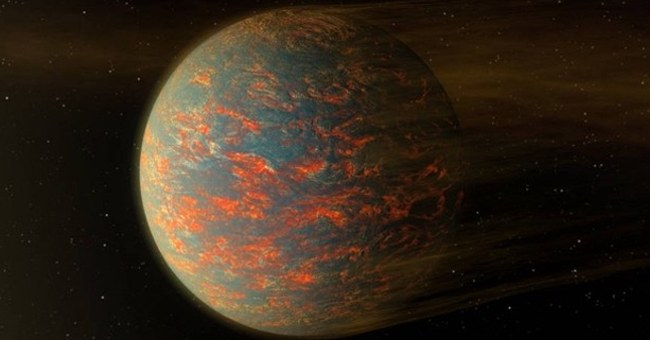NASA revealed heat map of super-earth
The US Aeronautics and Space Administration (NASA) on March 30 drew a heat map on the super-earth 55 Cancri e, showing great thermal fluctuations between the day and night here.

Illustration of NASA about the temperature on the planet 55 Cancri e.(Photo: NASA)
NASA maps heat on 55 Cancri e based on data from Spitzer Space Telescope . This is the first time scientists have sketched the heat map of a planet outside the solar system .
'The new findings tell us that the planet has a high temperature at night and is even hotter in the daytime ,' CNN quoted Brice Olivier Demory, an astronomer at NASA.
55 Cancri e also orbits a star like the earth orbiting the sun. However, this planet is too close to the star and goes through an orbit within 18 hours.
One side of it is always facing the star. The heat map shows that this face has temperatures as high as 2,400 degrees Celsius , while the planet's dark side is just over 1,100 degrees Celsius.
This shows that the ability to transfer heat on this planet is not good. The face facing the star may appear magma rivers, large lakes with extremely hot lava.
However, the planet's lava in the dark may have frozen as lava in the island of Hawaii, US scientist Michael Gillon, who specializes in studying extrasolar planets of Liege University (Belgium). , said.
Planet 55 Cancri e was discovered in 2004. It is only 40 light-years from Earth. The celestial body is classified as super-earth , ie the actions outside the solar system are more massive than the earth but lighter than the giant gas planets like Hai Vuong Tinh.
Super-earths are usually composed of gas and stones. Planet 55 Cancri e is twice as big and 10 times heavier than our planet. Some scientists believe that super-Earth has a better ability to sustain life than planets of the same size as the Earth.
- Exotic planets also have stratosphere like Earth
- NASA revealed information about large asteroids just hitting the Earth
- NASA discovered a 'super Earth' evaporating
- NASA reveals two narrow asteroids 'swinging fists' into Earth
- NASA revealed 3 super commercial aircraft models
- NASA revealed the explorer machine withstand 450 ° C
- NASA's super-high pressure balloon crawls near the Earth
- NASA expert revealed
- NASA revealed super missiles that brought people to Mars
- NASA scientific equipment draws heat maps from Europe from space
- NASA accidentally 'revealed' the video of 3 mysterious objects leaving Earth
- The earth may be 'scorched' because of heat after 85 years
 Van Allen's belt and evidence that the Apollo 11 mission to the Moon was myth
Van Allen's belt and evidence that the Apollo 11 mission to the Moon was myth The levels of civilization in the universe (Kardashev scale)
The levels of civilization in the universe (Kardashev scale) Today Mars, the sun and the Earth are aligned
Today Mars, the sun and the Earth are aligned The Amazon owner announced a secret plan to build a space base for thousands of people
The Amazon owner announced a secret plan to build a space base for thousands of people NASA's 'Ninth Planet' Shows Signs of Being Friendly to Life
NASA's 'Ninth Planet' Shows Signs of Being Friendly to Life  Which planet is the oldest and youngest in the Solar System?
Which planet is the oldest and youngest in the Solar System?  Breakthrough discovery of planet with more water than Earth
Breakthrough discovery of planet with more water than Earth  How would humans die when visiting other planets?
How would humans die when visiting other planets?  Habitable planet appeared next to Earth, but met with disaster
Habitable planet appeared next to Earth, but met with disaster  Chinese spacecraft discovers mysterious cubes on other planets
Chinese spacecraft discovers mysterious cubes on other planets 